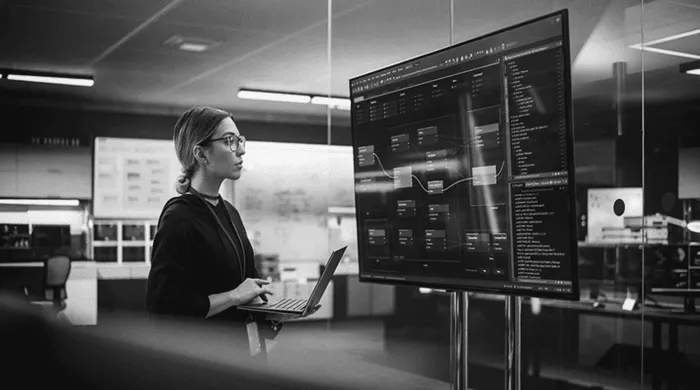15
+
YEARS OF
EXPERIENCE
1000
+
SUCCESSFUL
Projects
80
+
Satisfied
Clients

In today’s digital landscape, cybersecurity is a vital priority for organizations of all sizes. Businesses face increasingly sophisticated cyber threats that require vigilant monitoring and rapid response to safeguard sensitive data and infrastructure. Choosing between a Managed Security Operations Center (SOC) and an in-House SOC is a pivotal decision that impacts both security posture and operational costs. This article explores these two distinct approaches, helping IT leaders understand their options for maintaining robust cyber defenses in a dynamic threat surroundings.
Understanding Managed SOC vs In-House SOC: Core Differences and Strategic Value
When organizations evaluate cybersecurity management, the choice often comes down to implementing a Managed SOC or building an In-House SOC. A Managed SOC is an outsourced service where a specialized provider like TechCloud IT services L.L.C’s Cloud Technologies handles continuous security monitoring, threat detection, and incident response. This approach leverages dedicated security experts and advanced technologies without the burden of internal resource management. Conversely, an In-House SOC is operated internally by the association’s security team, providing direct control over cybersecurity operations, tailored to specific business needs but demanding significant investment in personnel, infrastructure, and ongoing training.
The decision between these models fundamentally rests on a business’s size, budget, risk tolerance, and regulatory requirements. While an in-House SOC offers customization and internal control, it may strain resources and face talent shortages. Managed SOC services mitigate these challenges by offering scalability, 24/7 vigilance, and access to the latest threat intelligence and tools. Understanding these core differences is essential for IT leaders aiming to align security operations with their strategic goals while optimizing costs and efficiency.







Evaluating Managed SOC vs In-House SOC: A Practical Guide for Modern Enterprises
Choosing between a Managed Security Operations Center (SOC) and an In-House SOC requires a clear understanding of the benefits and challenges associated with each model. Below is a structured comparison to help enterprises make an informed decision.
- Expertise and Resources
Managed SOC:- Provides access to experienced cybersecurity professionals with up-to-date threat intelligence.Utilizes advanced tools like SIEM, SOAR, and automated analytics.
- Requires recruiting, training, and retaining skilled analysts.
- Demands ongoing investment in tools and certifications.
- Cost and Scalability
Managed SOC:- More cost-effective for small to mid-sized organizations.Offers flexible service levels as business needs evolve.
- High initial setup costs (hardware, software, staffing).
- Scalability is dependent on internal resource availability.
- Operational Control and Customization
Managed SOC:- Limited control over processes and technology stack.Needs strong collaboration with internal teams for seamless integration.
- Full control over policies, processes, and security architecture.
- Can tailor defenses to specific industry or regulatory requirements.
- Compliance and Data Sovereignty
Managed SOC:- May raise concerns regarding data residency and regulatory compliance.Must ensure SLAs and contracts address legal obligations.
- Greater transparency and alignment with internal compliance needs.
- Better suited for sectors with strict data control policies (e.g., finance, healthcare).
- Availability and Coverage
Managed SOC:- Offers 24/7 monitoring without straining internal teams.Ensures continuous threat detection and rapid incident response.
- Requires round-the-clock staffing, shift planning, and redundancy.
- Can be challenging for smaller teams to maintain 24/7 vigilance.
Making the Right SOC Decision for Your Business
Managed SOCs are ideal for enterprises seeking agility, scalability, and cost-efficiency without compromising on proactive threat monitoring. In contrast, In-House SOCs appeal to organizations with large security budgets, strict regulatory demands, or a need for full operational control. The best-fit approach depends on aligning your cybersecurity strategy with your business goals, internal capabilities, and risk tolerance. Whichever model you choose, ensuring it integrates seamlessly with your broader IT and governance frameworks is essential to maximizing long-term security resilience.

Managed SOC solutions align security expertise directly with advanced technologies, offering dynamic threat detection and rapid response without heavy capital expenditure. In contrast, In-House SOCs offer enhanced customization but require sustained investment in talent and infrastructure. Both models present strategic trade-offs that every modern enterprise must consider carefully.
Case Studies and Practical Insights: Managed SOC vs In-House SOC Implementations in Action
Real-world examples provide valuable insights into how businesses benefit from either Managed or In-House SOCs. Consider a mid-sized financial services firm that opted for a Managed SOC provided by Cloud Technologies. Facing a shortage in cybersecurity talent and regulatory pressure for continuous monitoring, this firm leveraged our 24/7 security operations to detect advanced persistent threats and meet compliance mandates without stretching internal resources. The Managed SOC’s customizable dashboards and incident reporting allowed seamless integration with their internal IT team, considerably improving incident response speed and reducing operational fatigue.
Conversely, a global manufacturing company chose to build an In-House SOC to maintain stringent control over intellectual property protections and comply with multiple international data privacy laws. Despite a higher cost base, the company invested in comprehensive analyst training and advanced security tools within their facility. This in-house approach enabled rapid internal communications during cyber incidents and tailored defense mechanisms aligned with their unique operational technologies. However, they recognized challenges with staffing 24/7 shifts and compensating for analyst burnout, necessitating supplementary support agreements with external providers.
These case studies highlight that no one-size-fits-all solution exists. Organizations weigh factors like budget constraints, regulatory climates, risk profiles, and available talent pools to determine the most suitable SOC strategy. Partnering with a trusted provider like TechCloud IT Services L.L.C through Cloud Technologies enables businesses to tailor solutions that integrate with their culture, compliance needs, and growth trajectories.

answer time
satisfaction
score
on initial call
same business
day
Making The Informed Decision: Choosing Between Managed SOC vs In-House SOC For Sustained Security Excellence
Deciding between a Managed SOC and In-House SOC is a critical strategic choice that influences an organization’s cybersecurity strength and operational efficiency. Managed SOCs offer agility, access to seasoned experts, and cost-efficiency, enabling companies-especially small to mid-sized enterprises-to maintain robust defenses amid evolving cyber threats. In contrast, in-House SOCs provide deeper customization and direct oversight, favored by organizations with specialized security requirements and sufficient internal resources to support continuous betterment.
At TechCloud IT services L.L.C, we recognize that cybersecurity is not merely a technical requirement but a strategic enabler. Our Cloud Technologies Managed SOC service delivers proactive monitoring, threat intelligence, and rapid incident response tailored to your industry and compliance landscape. By combining our expertise with your internal insights, we help position your organization to anticipate and neutralize risks effectively.
We invite you to connect with us to explore how our Managed SOC services can augment your security operations, or discuss how a hybrid approach might best serve your unique context. Ultimately, informed decisions backed by trusted partnerships form the foundation of sustained security resilience in today’s fast-moving threat environment.


